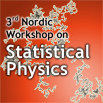Speaker
Prof.
Lene Oddershede
(Niels Bohr Institute, Copenhagen)
Description
In a living cell DNA and RNA are constantly subject to
forces causing the nucleic acid structures to twist, bend,
stretch, open, or melt. In order to understand important
cellular processes and the physical mechanisms that nucleic
acids obey, it is important to know how these nucleic acid
structures comply to mechanical stress. By applying forces
on individual DNA and RNA molecules, we investigated their
response while being forced to undergo a non-equilibrium
structural transition. Precise force-extension measurements
performed on DNA by optical tweezers prompted a
re-formulation of the celebrated worm-like chain model, our
new model is denoted the 'twistable worm-like chain' and
takes into account the observed twist-stretch coupling [1].
In the DNA overstretching regime, the so-called
'force-plateau', we consistently observed a reproducible
rip-like structure in the data which originated from a
mechanical unpeeling of the two strands [1]. RNA is another
nucleic acid of poss
ibly even more importance than DNA.. During translation mRNA
pseudoknots are subject to a mechanical force acted upon the
structure by the translating ribosome. This force causes the
structure to open and occasionally the ribosome to shift
reading frame. Using an optical trapping assay we mimicked
the action of the ribosome by forcing mRNA pseudoknots to
unfold in a non-equilibrium fashion. We found that the
frameshifting efficiency correlates with the mechanical
strength of the structure [2], however, the relation is not
trivial as an inversion of the structure has a tremendous
effect both on frameshifting rates, on Gibbs free energies,
and on its mechanical strength. Occasionally, the mRNA
pseudoknot is so strong that it efficiently acts as a
roadblock for e the translating polymerase [3].
[1] Twist, stretch and melt: quantifying how DNA complies to
tension. P. Gross, N. Laurens, L.B. Oddershede, U.
Bockelmann, E.J.G. Peterman, G.J.L. Wuite, Nature Physics,
vol.7 p.731 (2011).
[2] Correlation between mechanical strength of messenger RNA
pesudoknots and ribosomal frameshifting, T.M. Hansen, S.N.S.
Reihani, L.B.Oddershede, M.A. Sørensen, PNAS vol.104 p.530
(2007).
[3] mRNA pseudoknots act as ribosomal roadblocks, J.
Tholstrup, L.B. Oddershede, M.A. Sørensen, Nucleic Acids
Research vol.40 p.303-313 (2012).

